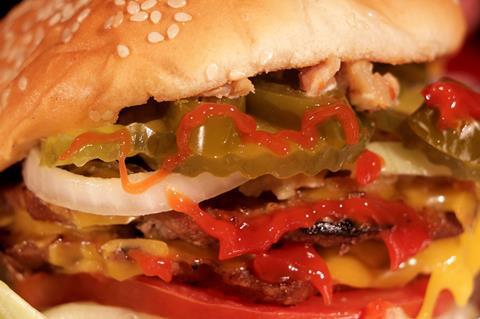A major food poisoning outbreak 30 years ago linked to a fast food chain changed how we tackle food safety - so why does the pathogen responsible keep popping up?
Thirty years ago, an unusual food poisoning incident linked to consumption of hamburgers from a fast-food chain, Jack-in-the-Box, sparked a large-scale investigation in the USA.
The outbreak resulted in a previously unseen high level of haemolytic ureic syndrome (HUS) in children. Unfortunately, the infection was fatal for some. The outbreak was widespread, infecting more than 700 people over four states in the USA and in Canada.
Promoted: AMI has teamed up with QIAGEN to help you get the highest yields from your soil DNA Extractions. Get your free guide here.

The pathogen was identified as a toxigenic Escherichia coli serotype O157:H7 and traced back to slaughterhouses in the USA and Canada. This wasn’t the first association of this pathogen with undercooked hamburgers, with outbreaks in two separate USA states 10 years earlier. Multiple E. coli O157:H7 outbreaks had occurred in the 1990s, including a massive outbreak in Japan in 1999 affecting around 6,400 school children, also with fatalities. The largest fatal outbreak in the UK was linked to a butcher’s premises in 1997, although the pathogen had been recorded before in Scotland.
Landmark incident
The Jack-in-the-Box outbreak was a landmark incident, raising awareness of an emerging pathogen and disease aetiology. The 1990s outbreaks changed the face of food safety, especially around how meat was cooked and for the separation of raw and cooked foodstuffs, and for culpability from foodborne disease. Since then, we have gained a wealth of knowledge about the disease, the enterohemorrhagic E. coli pathogen and the risk factors. Yet, the incidence of disease from this pathogen remains high, and large-scale outbreaks continue to be reported. The question is why.
The group of E. coli responsible for the disease is characterised by carriage of the Shiga or Vero-toxin (also in some Shigella species taxonomically related to these E. coli). Collectively they are known as Shigatoxigenic / verocytotoxigenic E. coli (STEC / VTEC). Although typified by the serotype O157:H7, they comprise a genetically diverse group of multiple serotypes, with varying degrees of pathogenicity dependent on their repertoire of virulence factors.
Complex risk management
The diversity is mostly down to the mobility of the temperate bacteriophage that encode the Shiga toxin genes (stx), which has a broad infective range. Risk management of the pathogen is complex because there are multiple genetic variants of stx that continue to evolve, each with different degrees of clinical pathogenicity. Furthermore, a key virulence factor that enables colonisation of human hosts, intimin (eae) is also evolving and diversifying.
Overall, this generates a complex picture requiring detailed genomic-level information to categorise the pathogen, and to assign risk. The O157:H7 serotype is no longer the most common, and the direction of travel is towards genetic diversity. What is driving this diversity is one of the key questions facing the STEC community today.

The primary host of STEC is in a defined ecological niche of ruminant intestinal tracts (mainly cattle), explaining the associations with undercooked beef and unpasteurised dairy products. However, STEC are easily spread and persist well in the wider environment, colonising secondary hosts and habitats. This results in foodborne transmission from multitude foodstuffs. Association with fresh fruit and vegetables is now as common as beef and dairy, principally from contaminated irrigation water, with leafy vegetables particularly at high risk.
Flour transmission
A more unusual vehicle of transmission is dough through apparent contamination in the flour, with infections on the rise. Whether this is down to increased risk awareness with good surveillance, or a genuine increase of this transmission route is unclear.
Furthermore, the source of the pathogen is also unclear. These outbreak strains are genetically diverse, raising questions about their ecological fitness in different settings, whether in food production facilities or in the wheat crop plants. Such a possibility is not unreasonable, as we have detected environmental E. coli as part of the native microbiota in other cereal plants. Furthermore, persistence in relatively dry environments is also feasible, likely contributing to the very large-scale outbreak of STEC O104:H4 from fenugreek seeds.

What’s next with STEC in food? The community needs to continue to work together across different disciplines and sectors, demonstrably shown in the triennial VTEC conference series. Within the clinical setting, the question focuses on the Shiga toxin type.
Multiple transmission routes
But for food safety, the picture comprises multiple transmission routes, for multiple STEC genotypes, occupying multiple hosts and habitats, overlaid by evolution of different tropic levels within the pathogen.
In the face of this increasing diversity, we need better surveillance tools than ever. Control relies on a hurdle approach, combining multiple approaches at critical control points. Our response has to keep up to date with changing land use and technological innovations in food production.
Like many other infectious diseases, STEC in its various guises is here to stay. That leaves it up to us as a community to continue to raise awareness of STEC pathogens, their sources, evolution and risk profiles.
Nicola Holden is a Professor of Food Safety at Scotland’s Rural College (SRUC). She works on plant-microbe interactions with a focus on STEC, and with other members of the plant microbiota.







No comments yet